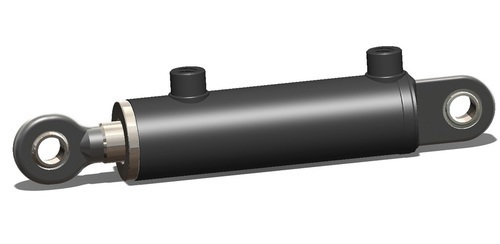Project Report For Hydraulic Cylinders
Introduction
Project report for Hydraulic Cylinders is as follows.
The hydraulic system of a machine includes hydraulic cylinders. Simply said, a hydraulic cylinder is an actuator that uses hydraulic energy to generate linear motion by converting it back to mechanical action. The hydraulic cylinder can be compared to a muscle since it generates movement via the machine’s hydraulic system, making it similar to a muscle.
The best machine designs typically mix hydraulic ratios with a mechanical force or torque ratio. In order for the hydraulic fluid to perform its function, it must reach the actuator and/or motors. Various types of valves are used to control flow, pressure direction, etc. A hydraulic circuit is the path followed by hydraulic fluid.

The vast amount of power that can be transported through small tubes and flexible hoses, high power density, and wide variety of actuators, such as hydraulic cylinders, that can use this power are what make hydraulic technology so popular. The conventional hydraulic jack, which connects a lifting cylinder with a large diameter to a pumping cylinder with a small diameter, is the application for which this is most frequently used.
Product & Its Application Of Hydraulic Cylinders
The mechanical actuator known as a hydraulic cylinder, also known as a linear hydraulic motor, is used to provide a unidirectional force through a unidirectional stroke. It has several uses, including automation of manufacturing machinery, robotics, appliances, earthmoving equipment, mining, industrial machinery and plants, and civil engineering.
The majority of the mineral oil used in hydraulic fluid under pressure pushes the piston and moves the piston rod in hydraulic cylinders. The piston rod is attached to a component or lever of a machine and performs work. The levers use mechanisms to change linear motion from rotating or oscillating motion.
The hydraulic cylinder is made up of a barrel-shaped cylinder in which a piston attached to a piston rod oscillates. The piston creates two chambers inside the cylinder: the bottom chamber (cap end) and the chamber along the piston rod’s side (rod end/head end). To stop leaks, the piston has sliding rings and seals. There are also seals on the cylinder head gland.
Get Completely Custom Bankable Project Report
Market Potential Of Hydraulic Cylinder
The global hydraulic cylinder market size was valued at USD 15.32 billion in 2021 and is expected to expand at a compound annual growth rate (CAGR) of 4.2% from 2022 to 2030
Expenses

Product Cost Breakup

Reveneue Vs Expenses

Market Trend

The industry is expanding as a result of the widespread usage of hydraulic cylinders in a variety of sectors, including material handling, building and infrastructure, marine, and earthmoving. The COVID-19 epidemic has caused significant volatility in global commodity prices, which has an effect on both the supply and demand of raw materials. Lockdown measures were enacted globally to stop the virus’s spread, which had a negative impact on the world economy.
The pandemic caused a severe recession and had an impact on manufacturing, which in turn affected demand for hydraulic cylinders. In 2021, the double-acting market segment held a commanding 70.0% share of global sales. Large-scale engines like ship motors, steam engines, industrial furnaces, earthmoving equipment, and other construction machinery all use double-acting hydraulic cylinders.
Over the projected period, the demand for double-acting hydraulic cylinders is anticipated to rise due to the rise in product demand in the aforementioned applications. These cylinders are used in hydraulic jacks, automated manufacturing environments, package and material handling, clamping, handheld machine drilling, and punching. Over the projection period, the expansion of the aforementioned applications is anticipated to increase the use of single-acting hydraulic cylinders.

